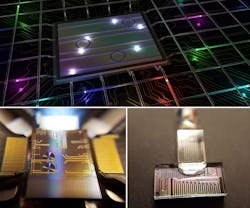Multi-colored photons and standard telecom components advance quantum photonics
With leading corporations now investing in highly expensive and complex infrastructures to unleash the power of quantum technologies, INRS researchers have achieved a breakthrough in a lightweight photonic system created using on-chip devices and off-the-shelf telecommunications components. As described in the Nature paper, the team demonstrates that photons can become an accessible and powerful quantum resource when generated in the form of color-entangled quDits.
RELATED ARTICLE: Laser-machined actuator strains QDs to emit tunable entangled photons
The system uses a small and cost-effective photonic chip fabricated through processes similar to those used for integrated electronics. With an on-chip microring resonator excited by a laser, photons are emitted in pairs that share a complex quantum state. The photons are constructed in a state featuring a number of superimposed frequency components: The photons have several colors simultaneously, and the colors of each photon in a pair are linked (entangled), regardless of their separation distance.
With each frequency—or color—representing a dimension, the photons are generated on-chip as a high-dimensional quantum state (quDit). Thus far, quantum information science has largely focused on the exploitation of qubits, based on two-dimensional systems where two states are superimposed (for example, 0 AND 1 at the same time, in contrast to classical bits, which are 0 OR 1 at any time). Working in the frequency domain allows the superposition of many more states (for example, a high-dimensional photon can be red AND yellow AND green AND blue, although the photons used here were infrared for telecommunications compatibility), enhancing the amount of information in a single photon.
To date, Professor Roberto Morandotti, who leads the INRS research team, confirms the realization of a quantum system with at least one hundred dimensions using this approach, and the technology developed is readily extendable to create two-quDit systems with more than 9,000 dimensions (corresponding to 12 qubits and beyond, comparable to the state of the art in significantly more expensive/complex platforms).
The use of the frequency domain for such quantum states enables their easy transmission and manipulation in optical fiber systems. "By merging the fields of quantum optics and ultrafast optical processing, we have shown that high-dimensional manipulation of these states is indeed possible using standard telecommunications elements like modulators and frequency filters," stresses telecommunications system expert professor José Azaña, co-supervisor of the conducted research.
The advances can be immediately transferred to quantum science using standard commercially available telecommunications systems and will directly enable fundamental investigations of high-dimensional quantum state characteristics, applications in large-alphabet fiber-based quantum communications, and the future development of frequency domain, high-dimensional quantum logic gates and other applications.
SOURCE: INRS University; http://www.inrs.ca/english/actualites/multi-coloured-photons-might-change-quantum-information-science

Gail Overton | Senior Editor (2004-2020)
Gail has more than 30 years of engineering, marketing, product management, and editorial experience in the photonics and optical communications industry. Before joining the staff at Laser Focus World in 2004, she held many product management and product marketing roles in the fiber-optics industry, most notably at Hughes (El Segundo, CA), GTE Labs (Waltham, MA), Corning (Corning, NY), Photon Kinetics (Beaverton, OR), and Newport Corporation (Irvine, CA). During her marketing career, Gail published articles in WDM Solutions and Sensors magazine and traveled internationally to conduct product and sales training. Gail received her BS degree in physics, with an emphasis in optics, from San Diego State University in San Diego, CA in May 1986.
